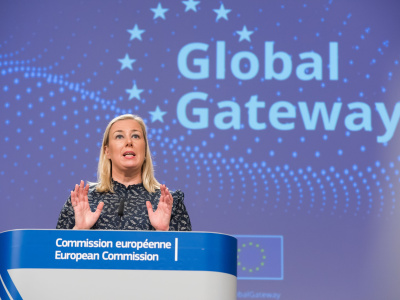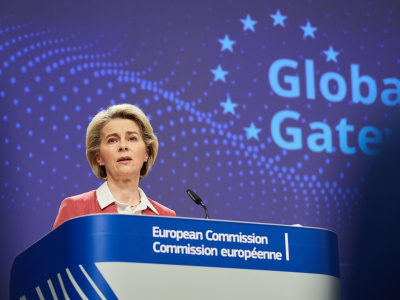
The EU Global Gateway – One year in: How to partner with the private sector?
This article was first published by GIZ as a contribution for a GIZ event on the Global Gateway strategy, organised on 30 November 2022.
The Global Gateway was launched with great fanfare a year ago, on 1 December 2021, by the European Commission and the High Representative for Foreign Affairs and Security Policy. It is presented as a positive offer by the European Union (EU) to boost smart investment in quality infrastructure development around the world, “a template for how Europe can build more resilient connections with the world”.
The focus of this new EU strategy is on supporting clean and secure, hard and soft infrastructure in digital, energy and transport sectors and strengthening health, education and research systems across the world.
It is meant to respond to the needs and strategic interests of different regions, in line with the EU’s interests and values, based on six key underlying principles: i) democratic values and high standards, ii) good governance and transparency, iii) equal partnerships, iv) green and clean (climate-neutral), v) security-focused, vi) catalysing private sector investment. Working through a Team Europe approach, the Global Gateway embodies a new, more assertive and ambitious EU approach.
Geostrategic investment at scale
Two main dimensions particularly captured the headlines and international community attention. The first relates to the rivalry with China and the declared geostrategic ambitions of the EU, with the Global Gateway strategy cast as a positive, value-driven, quality alternative to the Belt and Road Initiative.
The EU offer is framed in terms of sustainable development objectives and values – standard pillars of the EU development cooperation – and the EU’s own geopolitical and economic interests. This latter dimension is a major new articulation of the EU development engagement. It echoes the transformation of the European Commission Directorate-General (DG) International Cooperation and Development (DEVCO) into DG International Partnership (INTPA), which beyond the change of name, intends to reflect a shift of paradigm for the EU international cooperation from a donor-recipient relationship to partnership approaches, geopolitical aspirations, and a greater focus on the private sector and investment.
The Global Gateway embodies this systemic shift. It also reflects the frustration of the EU for the lack of recognition and political reward from being, collectively with the EU member states, the main global provider of development assistance and a major trade and investment partner of developing countries.
The Global Gateway reflects the frustration of the EU for the lack of recognition and political reward from being, collectively with the EU member states, the main global provider of development assistance and a major trade and investment partner of developing countries.
The second headline concerns the €300 billion investment tag attached to the Global Gateway for the period 2021-2027, half of which is destined for Africa. While public attention is focused on the overall amount, it is the approach that really matters.
The Global Gateway puts a strong emphasis on mobilising quality investment, actively engaging the private sector and leveraging private finance. To do so, the EU and its member states pursue a Team Europe approach, relying on their institutions for development, including their public development banks (PDBs) and financial institutions for development (DFIs), at national and EU levels. Together, they mobilise a broad range of international cooperation and development tools, including blended finance and guarantees.
In this regard, the European Fund for Sustainable Development plus (EFSD+) and External Action Guarantee should significantly contribute to empowering PDBs and DFIs to leverage more impactful investment at scale in a strengthened open European financial architecture for development (EFAD).
Partnering with the private sector
It is with this ambition that the EU seeks to engage more actively with the private sector in the Global Strategy. Mobilising the private sector takes many forms. The EU engages the private sector in public-private policy dialogues to improve the business environment in development and foster conducive investment policies and strategies. It can also support business development and micro, small and medium-sized enterprises (MSMEs).
The private sector also comes in the form of enhancing match-making and B2B activities and facilitating access to finance, including through concessional finance and risk mitigation mechanisms. Often, EU interventions encapsulate a combination of these various forms of private sector engagement, as in the case of the new flagship Investing in Young Businesses in Africa (IYBA) Team Europe Initiative (TEI), for instance.
Equity investment and other co-financing mechanisms, with PDBs/DFIs, and access to public procurement, are other common forms of catalysing private sector capacities, skills, and financial resources to achieve development and strategic objectives pursued under the Global Gateway.
A strengthened collaboration between European donors, development agencies, and PDBs/DFIs can also enhance opportunities for engaging with and mobilising the private sector. It is with these ambitions in sight that the EU seeks to more actively mobilise the private sector in partner countries, as well as within the EU.
A blurred picture?
As a new initiative, the Global Gateway is experiencing some growing pains. The first challenge is for all European actors and their partners in developing countries to really understand what’s new in the Global Gateway.
While building on existing instruments and frameworks can be an advantage, it is also difficult to decipher what’s new in practice in the Global Gateway. It draws heavily on the Neighbourhood, Development and International Cooperation Instrument (NDICI)-Global Europe, including the EFSD+, adopting the Team Europe approach around (flagship) TEIs. These would have happened even without the Global Gateway. So, what’s the added value of the Global Gateway?
Branding better European international actions is certainly one important aspect. Improving the visibility and recognition of the EU’s value-driven approach “for sustainable and trusted connections that work for people and the planet” is a clear developmental and geopolitical asset, including compared to systemic rivals such as China. It can benefit the European private sector, which arguably has a comparative advantage in providing more sustainable and high-standard solutions and finance.
Framing better the European international action in clearer geostrategic orientations and interests of the EU is another potential value of the Global Gateway. The comprehensive governance structure proposed for the Global Gateway, with the setting up of the Global Gateway Board, steered by the President of the European Commission, Ursula von der Leyen and the High Representative/Vice President of the Commission Josep Borrell, the establishment of a special working group under the Foreign Affairs Council, and, in particular, the proposal to establish a Business Advisory Group (BAG), could help provide a more strategic impulse to the EU strategy.
The role of the European private sector in the BAG remains to be clearly articulated, though. In this process, it is important to draw on private insights and know-how while avoiding the capture of development cooperation and finance by vested European private sector and geopolitical interests. It will also be important to closely associate the European PDBs and DFIs in this governance structure to tailor and timely mobilise development finance to the identified priorities.
Clarifying the process of the Global Gateway in engaging various actors should therefore be a priority. This is particularly relevant for the private sector. Given the strong action orientation of businesses and financiers, starting implementing key TEIs as part of the Global Gateway would facilitate the engagement of private sector actors.
Walking on one leg?
While the EU needs urgently to walk the talk on the Global Gateway, the question is whether it currently walks on one leg only. So far, the Global Gateway rests mainly on development cooperation instruments and finance. This is the one leg.
While the EU needs urgently to walk the talk on the Global Gateway, the question is whether it currently walks on one leg only. So far, the Global Gateway rests mainly on development cooperation instruments and finance. This is the one leg.
To achieve the geostrategic ambitions of the Global Gateway, based on the EU values and interests, a ‘whole-of-government’ approach would be needed, which in the European context would imply a ‘whole-of-the-EU’ approach, drawing on a range of policies, institutions and instruments at the EU level and its member states.
This is particularly the case for more actively engaging the European private sector. Interesting inspirations could be drawn from the US Partnership for Global Infrastructure and Investment (PGII), which mobilises an impressive range of US institutions to serve its strategic developmental infrastructure objectives.
More efforts should be made to harness export, trade and investment promotion and support initiatives and instruments, which for the time being, mainly rest on the member states. The EU could further elaborate on the linkages between its internal policies (e.g., on digitalisation, energy, green, etc.) and external ambitions, closely associating its private sector and public and private financial institutions.
The views are those of the author and not necessarily those of ECDPM.




